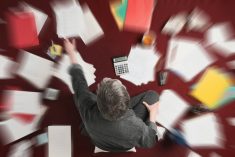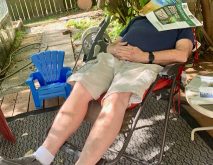In western Manitoba, a couple we’ll call Ezra, 58, and Lucy, 56, operate a third generation family farm with 1,280 acres of feed grains, oilseeds and a herd of 60 beef cows. The farm, with a value of $1.25 million plus $100,000 for the farm house, is profitable, but its future is clouded by the plans of their two adult children, their son, Edward, studying to be a plumber who may come home to continue the farm, and a daughter, Bella, who studied humanities in university and has no interest in farming.
Ezra and Lucy should be able to leave the farm to Edward, but before that happens, they should do some tax management. First move: make Lucy an equal partner in the farming operation. Her value for income splitting is greater than her value as a deductible dependent, notes Don Forbes, head of Forbes Wealth Management Ltd. in Carberry, Manitoba. Don, who worked on the plan with Erik Forbes, a principal at the advisory firm, say that if Ezra and Lucy follow the plan to smooth out their individual annual taxable farm income at $30,000 per year for each and take other measures to harvest value from the farming operation, they can retire in comfort.
Read Also

Gentle treatments for pain in the neck
Heading toward year-end, people unknowingly tense up against the cold and busyness, causing neck pain that can often be treated with appropriate support and gentle mobility, athletic therapist Kathlyn Hossack says.
They can use the money they take out of farm capital for off-farm investment. For example, they can fill up their Tax-Free Savings Accounts and add money to their non-registered savings. This money could serve as a legacy for their daughter.
At the moment, Ezra and Lucy have all their off-farm money invested in low yield guaranteed investment certificates. They could do much better if they were to move their money to dividend paying common stocks, so-called dividend aristocrats that have paid steadily rising distributions of corporate earnings for at least 10 years, notes Erik Forbes.
Getting started
Ezra and Lucy can also start a process of shifting fractions of the farm, say a quarter section at a time, to Edward. The parents would take back zero interest promissory notes. Edward would pay rent on the land to the parents. The note would be a forgiven obligation at the death of the second parent, Don Forbes suggests. The strategy of gradual transfer of farm capital to Edward will hold income tax down to about 26 per cent a year. The alternative is to defer taxes until death. The latter plan would put farm income distributions at risk of being taxed at a 50 per cent rate. Or more.
The risk is that the federal government may reduce the qualified farmland capital gain exemption, currently $1 million for each farm owner. The prudent thing is to make use of it while it exists, Don Forbes says.
The Alternative Minimum Tax can be charged when using a large credit like the farmland capital gains tax exemption. So when making use of the farmlands capital gains credit, the income tax calculation is done before application of the credit. If the capital gains tax payable in a given year exceeds $40,000, it will be necessary to pay additional tax. However, the AMT levied in a high capital gains tax year for which the farmland capital gain is used remains on the books as a credit toward future federal income tax payable. It becomes a way of prepaying tax, Erik Forbes adds.
In Ezra and Lucy’s case, the temporary cost of the AMT causes can be reduced by the slow transfer of just one or two quarters a year — the amount of land depending on gains in declared value. That should keep the capital gain tax owing under $40,000, Don Forbes explains. Liquidating cattle and crop inventories over several years can help to even out the potential tax burden.
RRSP contribution room can be preserved for years in which there is an income spike that pushes up the couple’s tax bracket. In the year of an auction sale, for example, when income rises, there is higher income that can be defended from progressive tax rates by making RRSP contributions. The goal should be to keep individual taxable income below $90,000, Don Forbes says.
RRSP accounts can be maintained to age 65, then converted to Registered Retirement Income Funds to take advantage of the $2,000 per year pension credit. The first $2,000 withdrawn each year per person will be tax-free and after that, RRIF income is taxed at the higher rate as ordinary income.
Tax-Free Savings Accounts can be used to the present maximum of $46,500 each. If both partners make the fullest use, then after 10 years with initial deposits of $46,500 augmented by $5,500 per person growing at three per cent per year after inflation, the balances will be $127,450 per person or $254,900 when Ezra and Lucy are 68 and 66, respectively. If this money continues to grow at three per cent with no further contributions and is paid out for the next 20 years so that the TFSA balances are zero in 2046, the couple would have $16,650 a year of non-taxable income, Erik Forbes estimates.
Further steps
There is more that Ezra and Lucy can do to boost their retirement income. They can invest in the AgriInvest program up to 1.5 per cent of qualifying commodity sales. The matching government grant is fully taxable when withdrawn prior to or at retirement, Don Forbes notes. Increased annual taxable income ultimately extra Canada Pension Plan entitlements, which boost eventual CPP pensions. It also raises the couple’s eligibility for CPP disability entitlements.
Edward, the son who will eventually return to the farm, can have land transferred to him at any price between the book value and current market value, Don Forbes notes. Bella could be given the value of the growing TFSAs if the total retirement income generated is far in excess of what Ezra and Bella need. This could be a very large sum if, for example, the TFSA grows at three per cent for 30 years. For the couple, both maximizing TFSA contributions of $5,500 a year each after making a $46,500 each contributions to fill space in 2016, the combined balance would be $764,800. The money, representing what might notionally be half of the farm’s present value, would go to Bella in lieu of a division of the estate. Just making her designated beneficiary of the TFSAs would be necessary. This is an efficient way of dividing the couples’ estate and far less costly than buying a comparable amount of life insurance late in life, Don Forbes says.
If Ezra and Bella retire when Ezra is 65, they will each have an estimated one-third of maximum Canada Pension Plan benefits of $13,110 at 2016 values or a combined total of $9,440, OAS benefits at 2016 rates of $6,846 (both in force when Bella is 65) of $13,692, tax credits of about $6,000, TFSA income of $16,650, RRIF income of $4,000 and continuing farm income of $30,000 each. That is a minimum of $109,782 annually. If taxed at an average rate of 25 per cent, they would have almost $6,900 a month to spend. That would more than exceed their present $3,600 a month expenses.
“We can solve most of the problems Ezra and Lucy have in dealing with the transition of their farm provided the couple adopts our plan and follows it,” Don Forbes says. “If they follow the plan, it will work for everyone, ensuring a smooth transition of ownership to the son and a good inheritance for the daughter.”














